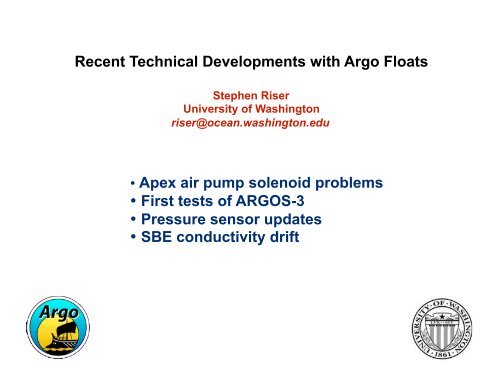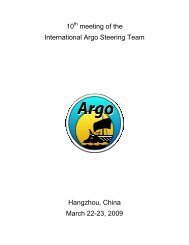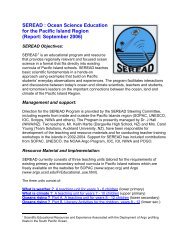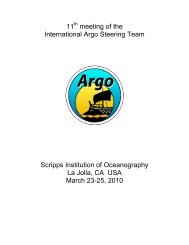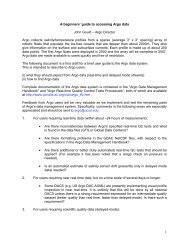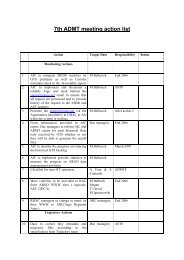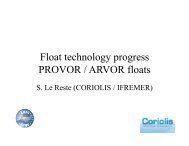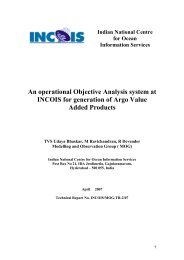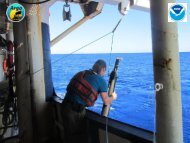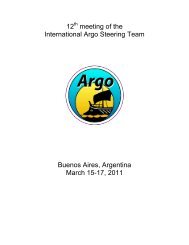Float technology progress - Riser - Argo
Float technology progress - Riser - Argo
Float technology progress - Riser - Argo
Create successful ePaper yourself
Turn your PDF publications into a flip-book with our unique Google optimized e-Paper software.
Recent Technical Developments with <strong>Argo</strong> <strong>Float</strong>s<br />
Stephen <strong>Riser</strong><br />
University of Washington<br />
riser@ocean.washington.edu<br />
• Apex air pump solenoid problems<br />
• First tests of ARGOS-3<br />
• Pressure sensor updates<br />
• SBE conductivity drift
Air pump (back)<br />
Air pump (front)<br />
The Apex air pump is used to<br />
inflate the air bladder at low<br />
pressures (< 100 dbar) so that the<br />
float rides on the sea surface with<br />
the antenna well out of the water.
UW- added PCB<br />
solenoid<br />
The air pump is controlled by a solenoid (switch), shown above. For<br />
reasons unknown, a number of these solenoids (cost: < $100) have failed<br />
in laboratory tests at UW in recent months. A failure in the field would<br />
mean the air bladder would not inflate, resulting in possible loss of the<br />
ability to communicate with a satellite. This is especially problematic for<br />
Iridium floats.
ACTIONS<br />
(1) The cause was found (by D. Swift) to be an inability of the solenoid to latch<br />
closed over the duration of an applied transient current. If the duration of the<br />
transient current was increased, the solenoid would always latch properly. There<br />
are no known changes in the controller electronics or the solenoid itself that<br />
would lead to this problem.<br />
(2) The problem can be corrected by adding a small, inexpensive (< $50) printed<br />
circuit board near the solenoid that regulates the current to the solenoid and<br />
insures that it always opens and closes on command. The board was designed<br />
by D. Swift, and 100 units were built commercially in Seattle. This fix has been<br />
added to all UW and PMEL floats since February 2011.<br />
(3) Individual floats can be tested for this problem by connecting a laptop prior<br />
to deployment and inflating the bladder.<br />
(4) Teledyne/Webb has been notified of this problem and the suggested remedy.<br />
As of March 1 2011 they have NOT instituted this remedy, and they continue to<br />
build and ship floats with this potential problem. It is not clear whether or not<br />
they intend to add the auxiliary PCB in their production process.
FIRST TESTS OF ARGOS-3 PMT:<br />
• UW has developed a prototype float that uses a Kenwood PMT to<br />
communicate with ARGOS-3 satellites. Reasons to do this: (1) ARGOS-3 will<br />
someday provide bidirectional communications, a possible alternative to<br />
Iridium; (2) the Seimac PTT used in Apex floats is no longer being<br />
manufactured, so alternative communication methods for Apex ARGOS floats<br />
need to be explored.<br />
• First tests of the Kenwood PMT have shown that energy use is larger than<br />
with present ARGOS-2 PTTs. The PMT float has been running on a simulator<br />
at UW for several months. The PMT consumes more than twice the energy per<br />
transmission of the present ARGOS-2 Seimac PTT or Telonics PTT units.
SeaBird CTD ISSUES:<br />
• SBE claims the microleak problem is now understood and fixed at the<br />
Druck factory. The glass/metal seals that caused the problem have been reengineered.<br />
These new sensors will be installed in SBE float CTDs<br />
beginning in July 2011. Until then, SBE is screening all Druck pressure<br />
sensors that are installed in float CTD units (possibly resulting in continued<br />
reduced production of CTD units).<br />
• SBE continues its warranty return program for CTDs with documented<br />
microleak or snowflake problems. A number of <strong>Argo</strong> groups have already<br />
received compensation. See the SBE website for details.<br />
• Kistler pressure sensors: some groups have tried these in tests (SIO, UW,<br />
PMEL, ??) with good results so far in a limited number of floats for a limited<br />
time. SBE claims laboratory tests show the Kistler sensor to be as good as<br />
or better than the new Druck sensors.<br />
• Conductivity drift: both Jamstec and PMEL have noted floats with<br />
unacceptable conductivity drift after deployment (>0.01 PSU equivalent).<br />
This problem was traced to erosion of the platinum in the CTD electrodes.<br />
The cause of the problem has been found and new QC procedures have<br />
been installed at SBE. It is believed that this problem occurred in an<br />
isolated group of floats (CTDs built late in 2010) but all groups should<br />
check for this.


